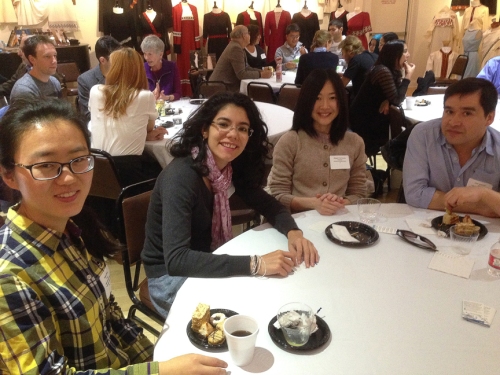
Seventy-three Fulbrighters participated in the 2014 Fall Welcome at the National Ukrainian Museum of Chicago
By Elio Leturia—OVER SEVENTY PARTICIPANTS among Fulbright students and scholars, alumni association members and Institute of International Education (IIE) representatives enjoyed a luncheon and tour that showcased another ethnic Chicago neighborhood: Ukrainian Village.
The 2014 Fall Welcome event took place last Saturday October 11, 2014 at the Ukrainian National Museum.

Anna Chychula from the Ukrainian National Museum welcomes the participants. Next to her, Ron Harvey, Chicago chapter president and Maria Klimchak, who also guided the museum’s tour
It was beautiful sunny fall day. Ron Harvey, president of Chicago Chapter of the Fulbright Association and 12 board members of the chapter welcomed all the participants, starting at 11 am. “There are 30 nationalities in this room,” Harvey said.
A delicious luncheon which consisted of different Ukrainian treats, were offered at the main room of the museum where a Ukrainian fashion show “A Century of Embroidered Fashion” that depicted 90 clothing pieces was being exhibited. These gowns, American produced, were all hand-embroidered with complex designs, the same way Ukrainians use in their typical clothing. There was also a piece that showed embroidered men’s ties.
This was the first Chicago Chapter activity for most of the student participants, which were given our Chicago Trivia game to learn Chicago facts, such as the Chicago River that runs backwards, the meaning of the Chicago flag, the nicknames for our “Second City,” among others.
Then, Anna Chychula and Maria Klimchak from the Ukrainian National Museum offered a tour of their installations where they have displays of typical embroidery, Pysanky (Ukrainian Easter Eggs,) traditional folk costumes, Bandura (national instrument of Ukraine) and also historical objects displayed at the Cossak Rook that contains paintings and swords, and different artifacts from the 1800s.

Recently arrived Fulbrighters talk with current students and alumni, exchanging their own experiences
According to its website, the museum collection that started in 1952, “consists of over 1,140 artifacts including those related to traditional folk arts, agricultural tools, artwork, musical instruments, trophies” and hosts a library with over 20,000 titles.
Photos: Maria Klimchak, Elio Leturia





